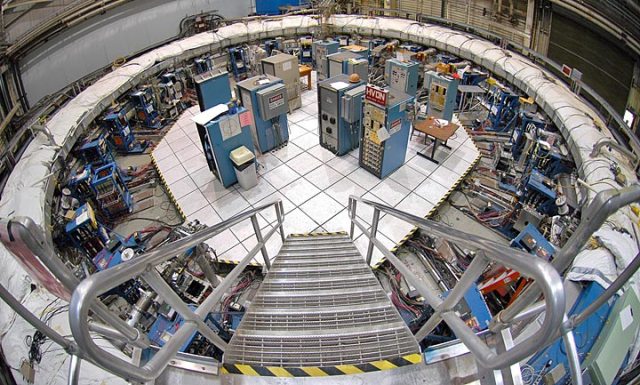May 10 2013
Scientists from 26 institutions around the world are planning a new experiment that could open the doors to new realms of particle physics. But first, they have to bring the core of this experiment, a complex electromagnet that spans 50 feet in diameter, from the U.S. Department of Energy's Brookhaven National Laboratory in New York to the DOE's Fermi National Accelerator Laboratory in Illinois.
 The Muon g-2 storage ring, in its current location at Brookhaven National Laboratory. The ring, which will capture muons in a magnetic field, must be transported in one piece, and moved flat to avoid undue pressure on the superconducting cable inside.
The Muon g-2 storage ring, in its current location at Brookhaven National Laboratory. The ring, which will capture muons in a magnetic field, must be transported in one piece, and moved flat to avoid undue pressure on the superconducting cable inside.
The experiment is called Muon g-2 (pronounced gee-minus-two), and will study the properties of muons, tiny subatomic particles that exist for only 2.2 millionths of a second. The core of the experiment is a machine built at Brookhaven in the 1990s, and the centerpiece of that machine is a circular electromagnet made of steel and aluminum, 50 feet wide, with superconducting cable inside.
"It costs about 10 times less to move the magnet from Brookhaven to Illinois than it would to build a new one," said Lee Roberts of Boston University, spokesperson for the Muon g-2 experiment. "So that's what we're going to do. It's an enormous effort from all sides, but it will be worth it."
While most of the machine can be disassembled and brought to Fermilab in trucks, the massive electromagnet must be transported in one piece. It also cannot tilt or twist more than a few degrees, or the complex wiring inside will be irreparably damaged. The Muon g-2 team has devised a plan to make the 3,200-mile journey that involves loading the ring onto a specially prepared barge and bringing it down the East Coast, around the tip of Florida and up the Mississippi River to Illinois.
The ring is expected to leave New York in early June, and land in Illinois in late July. Once it arrives, the ring will be placed onto a truck built just for this purpose, and driven to Fermilab in Batavia, a suburb of Chicago. The land transport portions on both the New York and Illinois ends of the trip will occur at night - to minimize traffic delays - and the truck will only travel, at most, 10 miles per hour. On the New York end, the trip from Brookhaven Lab's gate to the departure port should take one night. The complete trip from the Illinois port to Fermilab should take two consecutive nights.
"The transport of the ring from Brookhaven to Fermilab is a great example of the cooperation that exists between national laboratories," said James Siegrist, associate director of science for high-energy physics with the U.S. Department of Energy. "The Muon g-2 experiment is an important component of the future of particle physics in the United States."
Once at Fermilab, the storage ring will be used to hold muons created in the laboratory's accelerators. Muons "wobble" when placed in a magnetic field, and based on what we know about the universe, scientists have predicted the exact value of that wobble. An experiment using the same machine at Brookhaven in the 1990s saw evidence for - though not definitive proof of - a departure from that expected value.
"Fermilab can generate a much more intense and pure beam of muons, so the Muon g-2 experiment should be able to close that margin of error," said Chris Polly, project manager for Fermilab. "If we can do that, this experiment could indicate that there is exciting science awaiting beyond what we have observed."
The experiment is scheduled to begin taking data in 2016.
"The ring is a wonder of scientific engineering," said William Morse of Brookhaven. "We're extremely proud of it, and excited to see it used in this next-generation experiment."